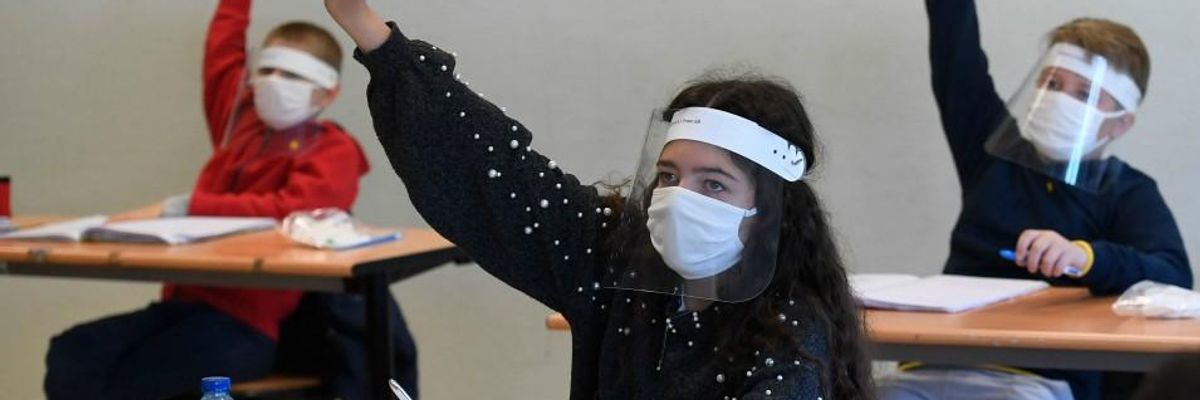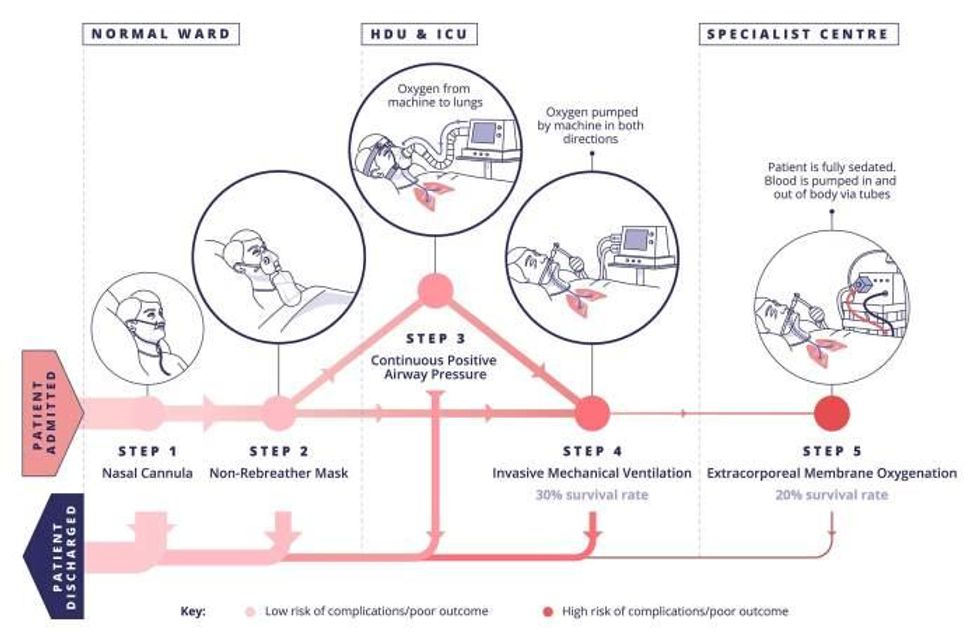Opening schools unsafely will not solve any of our problems.
In every case, it will make them worse.
Students don't learn a lot when their teachers are in quarantine.
Children generally receive less socialization when their parents are hospitalized.
Kids with special needs will receive few accommodations on a respirator.
Childcare is the least of your worries when planning a funeral for a family member.
No matter what need schools usually meet, Coronavirus makes the situation worse.
Every. Time.
People propose having in-person classes or hybrid models that mix in-person classes with online instruction.
But from an epidemiological point of view, it makes more sense to keep the buildings closed and provide what we can on-line.
Unless perhaps you live in some secluded county that has had extremely low infection rates for a prolonged period of time.
Otherwise, this truth holds no matter from what angle you approach it - academic, economic, political, whatever.
After all, academics don't mean much when you're seriously ill. The economy doesn't matter a lot when you're dead. And politics won't do you much good with lifelong health complications.
If we reopen schools, we invite COVID-19 into the classroom just as well as students.
So far as we know, the virus doesn't care what your motivations are. It only infects as many people as it can leaving us to deal with the consequences.
Consider what the virus does to the human body.
According to the Center for Disease Control (CDC), exposure to the virus can result in mild symptoms to severe illness up to two weeks later. These include fever or chills, cough, shortness of breath or difficulty breathing, fatigue, muscle or body aches, loss of taste or smell, sore throat, nausea or vomiting and/or diarrhea.
People who are sick should stay home, monitor their symptoms and separate themselves from other members of the household.
You should seek immediate medical care if you experience trouble breathing, persistent pain or pressure in the chest, confusion, inability to stay awake and/or bluish lips or face.
Severe illness often requires hospitalization that attempts to relieve the most common complications. These are things like pneumonia, hypoxemic respiratory failure/ARDS, sepsis and septic shock, cardiomyopathy and arrhythmia, and acute kidney injury.
However, you also have to beware additional complications from prolonged hospitalization. These can include secondary bacterial infections, thromboembolism, gastrointestinal bleeding, and critical illness polyneuropathy/myopathy.
Managing blocked airways is a particular concern. This can be done in less severe cases with simple nasal cannula or oxygen rebreather masks. However, in more extreme cases, you may need continuous airway pressure provided through a machine or even invasive mechanical ventilation.

The chances of this happening to you or a loved one because your neighborhood school building was reopened and children were exposed to potentially sick classmates and staff is far from negligible.
In the US, more than 150,000 people have died from COVID-19. That's 3.4% of cases that have lead to death.
To put that in context, The US has 5% of the global population and nearly a quarter of all Coronavirus deaths.
Over this last week, the average daily deaths in Italy were 6, France 10 and Spain 2.
In the US it was 1,204.
And make no mistake. Children can and do get sick - especially those 10 and older. They also can and do spread the virus to others.
Around the world, school closures are the rule, not the exception. While a few countries have opened schools, 143 countries have closed them nationwide.
This isn't just because of the chance of death.
There are potential long term effects for survivors, too.
These include inflammation of the heart, cardiovascular disease and strokes; lung inflammation including persistent shortness of breath; and neurological issues such as headaches, dizziness, trouble concentrating or recalling things and even hallucinations.
This will not solve any of our current problems.
It will only make them worse.
However, I don't wish to be dismissive.
Many kids and families are struggling with school closures.
Teachers and classrooms provide necessary services way beyond simple education.
I'm talking about food, nutrition, healthcare, childcare, counseling, tutoring, socialization, self esteem, meeting special needs, protection from abuse and a whole lot more.
If we keep school buildings closed and go to distance learning as we did in March, many of these services will continue to be disrupted or completely severed.
While reopening school buildings is NOT a viable solution, there are other things we can do.
Food, nutrition and healthcare can all be met while conducting distance learning. In fact, most schools provided these services from March through June as classrooms across the country were closed.
Likewise, counseling, tutoring, socialization, and self esteem can be provided on-line. In most cases they won't be as effective as they would be in a physical setting. However, given the precautions necessary to meet in-person - face masks, social distancing, etc. - they may be more effective screen-to-screen than they would be mask-to-mask.
Which brings me to the most difficult considerations - meeting special needs, protection from abuse, and childcare.
Not all students are neurotypical. Many require accommodations that are difficult or impossible to make in a virtual environment.
Special arrangements could be made for these students to come into the physical classroom on a part-time or full-time basis. This isn't as safe as complete on-line learning, but if the numbers of students are small enough, precautions such a temperature screenings and social distancing were in place and exposure mitigated, this could be a viable option.
The same goes for protection from abuse. Some students live in unsafe home environments. It is observation by responsible adults who are mandated reporters like teachers that reduce the likelihood these children will be mistreated and provide a solution when abuse is reported. However, noticing the telltale signs of such mistreatment or even communicating with a teacher privately outside of the hearing of an adult in the home is more difficult on-line.
Special arrangements could be made for students who have already been identified as at risk. They could meet with counselors and psychologists in the school every week or so. Safety precautions would be necessary but the risk could be reduced enough to make it worth taking.
The biggest problem is probably the most widespread - childcare.
Having children at home to do their schoolwork on-line puts additional pressure on parents.
It requires them to perform some of the disciplinary functions typically provided by educators. Parents have to ensure their kids are awake and ready to do their lessons. They have to monitor their children and help ensure the work gets done
This is less difficult for parents with higher socioeconomic status who have jobs that allow them to work from home. But for those who do not have such employment, it becomes almost impossible.
In short, the economy requires some kind of daycare for these children.
Many European countries that have best managed the Coronavirus have paid workers to stay home. This allows them to take care of their own children and reduce their own exposure to the virus.
Frankly, it is the only sustainable solution.
However, our government has almost completely abrogated its responsibilities to working class people.
Parents with similar age children can create childcare networks where the same families take turns watching each others' children. This reduces exposure to some degree.
Childcare centers also have been kept open in many communities to meet this need. However,there have been massive outbreaks at such centers across the country that would only be worsened if we rely on them more. Any sane country would close them just as it closed schools.
Until our lawmakers get off their butts and do their jobs, we will have no good solution to this problem.
Reopening school buildings to serve as childcare centers certainly won't solve anything except put a premium on respirators, coffins and graveyard plots.
And for those who respond that only a certain percentage of children and adults will die, which members of your family are you willing to sacrifice?
Whose lives are you willing to bet and do you really have the authority to play God?
That point cannot be made too often.
We're talking about human life here.
Reopening schools is seen as a silver bullet to so many of our problems during the pandemic.
It isn't.
It is shooting ourselves in the foot.
If we really want to solve our issues, we need to listen to science, logic and reason.
We need to keep schools closed and teach students online until the virus is under control.
We need to make it possible for parents to stay home with their children.
And we need to do it now.


